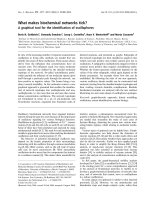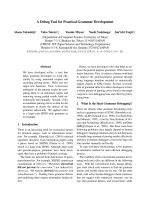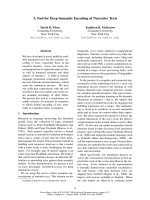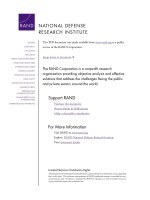A Portfolio-Analysis Tool for Missile Defense (PAT-MD) - Methodology and User docx
Bạn đang xem bản rút gọn của tài liệu. Xem và tải ngay bản đầy đủ của tài liệu tại đây (2.94 MB, 98 trang )
THE ARTS
CHILD POLICY
This PDF document was made available from www.rand.org as a public
service of the RAND Corporation.
CIVIL JUSTICE
EDUCATION
ENERGY AND ENVIRONMENT
Jump down to document6
HEALTH AND HEALTH CARE
INTERNATIONAL AFFAIRS
NATIONAL SECURITY
POPULATION AND AGING
PUBLIC SAFETY
SCIENCE AND TECHNOLOGY
SUBSTANCE ABUSE
The RAND Corporation is a nonprofit research
organization providing objective analysis and effective
solutions that address the challenges facing the public
and private sectors around the world.
TERRORISM AND
HOMELAND SECURITY
TRANSPORTATION AND
INFRASTRUCTURE
WORKFORCE AND WORKPLACE
Support RAND
Purchase this document
Browse Books & Publications
Make a charitable contribution
For More Information
Visit RAND at www.rand.org
Explore RAND National Defense Research Institute
View document details
Limited Electronic Distribution Rights
This document and trademark(s) contained herein are protected by law as indicated in a notice appearing
later in this work. This electronic representation of RAND intellectual property is provided for noncommercial use only. Permission is required from RAND to reproduce, or reuse in another form, any
of our research documents for commercial use.
This product is part of the RAND Corporation technical report series. Reports may
include research findings on a specific topic that is limited in scope; present discussions of the methodology employed in research; provide literature reviews, survey
instruments, modeling exercises, guidelines for practitioners and research professionals, and supporting documentation; or deliver preliminary findings. All RAND
reports undergo rigorous peer review to ensure that they meet high standards for research quality and objectivity.
A Portfolio-Analysis Tool
for Missile Defense
(PAT–MD)
Methodology and User’s Manual
Paul Dreyer, Paul K. Davis
Prepared for the Missile Defense Agency
Approved for public release; distribution unlimited
The research described in this report was prepared for the Missile Defense Agency. The
research was conducted in the RAND National Defense Research Institute, a federally
funded research and development center supported by the Office of the Secretary of
Defense, the Joint Staff, the unified commands, and the defense agencies under Contract
DASW01-01-C-0004.
Library of Congress Cataloging-in-Publication Data
Dreyer, Paul, 1973A portfolio-analysis tool for missile defense (PAT–MD) : methodology and user’s manual / Paul Dreyer,
Paul K. Davis.
p. cm.
“TR-262.”
Includes bibliographical references.
ISBN 0-8330-3801-X (pbk. : alk. paper)
1. Ballistic missile defenses—United States—Costs. 2. Investment analysis. I. Davis, Paul K., 1943–
II.Title.
UG743.D7435 2005
358.1'746'0973—dc22
2005009139
The RAND Corporation is a nonprofit research organization providing objective analysis
and effective solutions that address the challenges facing the public and private sectors
around the world. RAND’s publications do not necessarily reflect the opinions of its
research clients and sponsors.
R® is a registered trademark.
© Copyright 2005 RAND Corporation
All rights reserved. No part of this book may be reproduced in any form by any electronic or
mechanical means (including photocopying, recording, or information storage and retrieval)
without permission in writing from RAND.
Published 2005 by the RAND Corporation
1776 Main Street, P.O. Box 2138, Santa Monica, CA 90407-2138
1200 South Hayes Street, Arlington, VA 22202-5050
201 North Craig Street, Suite 202, Pittsburgh, PA 15213-1516
RAND URL: />To order RAND documents or to obtain additional information, contact
Distribution Services: Telephone: (310) 451-7002;
Fax: (310) 451-6915; Email:
Preface
This report documents the underlying methodology of a portfolio-analysis tool developed by
the RAND Corporation for the Missile Defense Agency’s Director of Business Management
Office (MDA/DM). It also serves as a user’s guide.
The report will be of interest primarily to MDA officials and analysts who develop
and assess the agency’s programs of research, development, testing and evaluation, and deployment for their ability to generate real-world ballistic-missile defense capabilities. It
should also be useful to some of MDA’s contractors, as well as to officials and analysts
throughout the Department of Defense, because portfolio-analysis methods and tools are
sorely needed for implementation of capabilities-based planning.
This is the first version of a new tool, so questions and comments are especially welcome and should be addressed to the project leader () or the principal developer () at RAND’s Santa Monica, CA, office.
This research was performed in the Acquisition and Technology Policy Center of
the RAND National Defense Research Institute (NDRI). NDRI is a federally funded research and development center sponsored by the U.S. Department of Defense. It conducts
research for the Office of the Secretary of Defense (OSD), the Joint Staff, the Unified Combatant Commands, the defense agencies, the U.S. Marine Corps, and the U.S. Navy. For
more information on the center, contact its director, Philip Antón (by e-mail,
, or by mail at RAND, 1776 Main Street, Santa Monica, CA,
90407-2138, telephone (310) 393-0411).
More information on RAND is available at .
iii
Contents
Preface .................................................................................................iii
Figures .................................................................................................ix
Tables ..................................................................................................xi
Summary ............................................................................................. xiii
Acknowledgments ................................................................................... xvii
Acronyms .............................................................................................xix
1. Introduction....................................................................................... 1
Background ........................................................................................ 1
Portfolio-Analysis Tools ........................................................................ 1
The Portfolio Analysis Tool for Missile Defense (PAT-MD) ................................. 1
Functionality .................................................................................... 2
Organization of the Report ........................................................................ 3
2. Overview of PAT-MD ............................................................................ 5
The Black-Box Perspective......................................................................... 5
Fundamental Terms and Concepts in PAT-MD .................................................. 6
The Baseline .................................................................................... 6
The Need to Generalize......................................................................... 7
Scoring and Aggregation Methods ................................................................. 8
PAT-MD Core Methods Using Thresholds, Goals, and Nonlinearity ......................... 8
Alternative Methods That Do Not Involve Thresholds ....................................... 10
Navigation, Inputs, and Outputs in PAT-MD ................................................... 10
Architecture and Navigation ................................................................... 10
Outputs ........................................................................................ 11
3. PAT-MD Input Sheets .......................................................................... 15
Data Entry Sheet .................................................................................. 15
Scoring and Aggregation-Function Control Parameters ....................................... 15
Control Parameters for Cost-Effectiveness .................................................... 17
Risk ............................................................................................ 17
Other Controls................................................................................. 17
Cost Data Sheet ................................................................................... 17
ESG Data Sheet ................................................................................... 18
Perspective Cases Sheet............................................................................. 19
Measure Comments and Weights Sheet ............................................................ 20
v
vi
A Portfolio-Analysis Tool for Missile Defense (PAT-MD)
IOC to Cost Data Sheet ........................................................................... 21
Dropdown Sheet ................................................................................... 22
4. PAT-MD Output Sheets ........................................................................ 23
Summary Sheet .................................................................................... 23
Details Sheet ...................................................................................... 25
Scatter Plot Sheet .................................................................................. 27
Spider Charts Sheet ................................................................................ 28
Multi-Measure Spider Charts Sheet................................................................ 29
Selected Details Sheet .............................................................................. 30
ESG Table Sheet .................................................................................. 31
Rankings Table Sheet .............................................................................. 31
IOC to Cost Output Sheet ......................................................................... 32
5. Details of the Methodology ..................................................................... 35
Basic Concepts and Definitions .................................................................. 35
Investment Options ............................................................................ 35
Attributes of the Investment Options ......................................................... 35
Relative Cost-Effectiveness..................................................................... 37
Methods and Functions........................................................................ 38
Alternative Methods Used in PAT-MD .......................................................... 39
The Need for Alternative Methods ............................................................ 39
Goals Method .................................................................................. 40
Weak Thresholds Method ..................................................................... 42
Thresholds Method ............................................................................ 43
Weakest Link Method ......................................................................... 44
Color Coding for the Goals and Thresholds Methods ........................................ 45
Rankings Method .............................................................................. 45
Color Coding for the Rankings Method....................................................... 47
Some Mathematical Observations ............................................................. 48
Examples of Scoring and Aggregation with the Different Methods .............................. 48
Goals Method .................................................................................. 48
Thresholds Method ............................................................................ 49
Weak Thresholds Method ..................................................................... 50
Weakest Link Method ......................................................................... 50
Rankings Method .............................................................................. 51
Marginal and Chunky Marginal Analysis......................................................... 51
Introduction ................................................................................... 51
Chunky Marginal Analysis..................................................................... 52
6. Concluding Observations ....................................................................... 57
Purpose and Function of PAT-MD .............................................................. 57
Limitations and Cautions ......................................................................... 57
PAT-MD as Software .......................................................................... 58
The Importance of the Measures, Submeasures, and Methods Used.......................... 59
Next Steps......................................................................................... 60
Contents
vii
Appendix
A. Comparison of Features of PAT-MD and DynaRank............................................ 61
B. Building a Portfolio View from the PAT-MD Template ......................................... 65
Bibliography .......................................................................................... 75
Figures
2.1.
2.2.
2.3.
2.4.
2.5.
2.6.
2.7.
3.1.
3.2.
3.3.
3.4.
3.5.
3.6.
4.1a.
4.1b.
4.2.
4.3.
4.4.
4.5.
4.6.
4.7.
4.8.
4.9.
5.1.
5.2.
5.3.
A.1.
B.1.
B.2.
B.3.
B.4.
B.5.
B.6.
B.7.
B.8.
B.9.
PAT-MD as a Black Box ...................................................................... 5
An Example Illustrating Measures, Submeasures, and Combining Rules..................... 6
Mapping of Raw Submeasure Values into Scores ............................................. 9
Some PAT-MD Worksheet Tabs ............................................................ 11
Schematic of Summary Sheet ................................................................. 12
Schematic of Details Sheet ................................................................... 12
Sample Output Displays from PAT-MD .................................................... 13
Data Entry Sheet.............................................................................. 16
Cost Data Sheet ............................................................................... 18
ESG Data Sheet .............................................................................. 19
Portion of Perspective Cases Sheet............................................................. 20
Measure Comments and Weights Sheet ........................................................ 21
IOC to Cost Data Sheet ....................................................................... 22
Left Side of Summary Sheet .................................................................. 24
Right Side of Summary Sheet................................................................. 24
Details Sheet .................................................................................. 26
Scatter Plot Sheet Showing Two Evaluation Metrics Versus Cost ........................... 27
Spider Charts (Radar Charts) Sheet ........................................................... 28
Multi-Measure Spider Charts Sheet ........................................................... 29
Selected Details Sheet ......................................................................... 30
ESG Table Sheet .............................................................................. 31
Rankings Table Sheet ......................................................................... 32
IOC to Cost Output Sheet..................................................................... 33
Generation of Scores, Effectiveness, and Cost-Effectiveness in PAT-MD ................... 36
Submeasure Score Versus Submeasure Raw Value for Goals and Thresholds Methods ..... 43
Cost-Effectiveness Comparisons for Two Perspectives....................................... 55
DynaRank Scorecard ......................................................................... 61
Block Structure of Cost Data Sheet for Two Investment Options ........................... 66
Block Structure of IOC to Cost Data Sheet................................................... 68
Data Entry Sheet.............................................................................. 70
Cost Data Sheet ............................................................................... 70
ESG Data Sheet .............................................................................. 71
Portion of Perspective Cases Sheet............................................................. 71
Measure Comments and Weights Sheet ........................................................ 72
Truncated Summary Sheet (Unfilled and Filled) ............................................ 72
Truncated Summary Sheet (with Results) ................................................... 73
ix
x
A Portfolio-Analysis Tool for Missile Defense (PAT-MD)
B.10. Details Sheet .................................................................................. 73
B.11. Template Builder Sheet ....................................................................... 74
Tables
2.1.
2.2.
2.3.
2.4.
5.1.
5.2.
5.3.
5.4.
5.5.
5.6.
5.7.
5.8.
5.9.
5.10.
5.11.
5.12.
5.13.
5.14.
5.15.
A.1.
Data for One Investment Option ............................................................. 7
Cost-Effectiveness Calculations ............................................................... 7
Core Aggregation Methods in PAT-MD...................................................... 9
PAT-MD Output and Input Sheets.......................................................... 11
PAT-MD Terminology ...................................................................... 38
Notation for Defining Scoring Methods ..................................................... 41
Mapping Measure Scores into Colors ........................................................ 45
Color Coding for the Rankings Method ..................................................... 47
Summary of Methods ........................................................................ 47
Scoring Methods for Three Investment Options ............................................ 48
Illustrative Results for the Goals Method .................................................... 49
Illustrative Results for the Thresholds Method .............................................. 49
Illustrative Results for the Weak Thresholds Method........................................ 50
Illustrative Results for the Weakest Link Method............................................ 51
Illustrative Results for the Rankings Method ................................................ 51
Contrived Data for Illustrative Problem ..................................................... 54
Performance of the Investment Options in Different Scenarios ............................. 54
Costs and Effectiveness Comparisons: Equal Emphasis on All Scenarios .................... 54
Costs and Effectiveness Comparisons: Extra Emphasis on Peer Threat ..................... 55
Comparison of DynaRank and PAT-MD ................................................... 63
xi
Summary
RAND’s Portfolio-Analysis Tool for Missile Defense (PAT-MD) was built to support highlevel discussion and decisionmaking in the Missile Defense Agency (MDA) by providing
summary portfolio-style characterizations of alternative investment options. These characterizations may involve projected capabilities in different missions, such as defense of the
homeland from long-range missile attacks; the balance of emphasis across missions; the managing of risks; and economic considerations such as relative cost-effectiveness. The portfoliostyle depiction attempts to provide a holistic, top-level view across all of these considerations
and is intended to facilitate discussion of program tradeoffs and adjustments. Equally important, PAT-MD and a companion tool, RAND’s Capabilities Analysis Model for Missile Defense (CAMMD), make it possible to “zoom” to higher levels of detail in order to understand the basis of high-level characterizations and how they would change if assumptions or
priorities were changed.
Characterizing Investment Options with PAT-MD
PAT-MD is a tool that can accommodate many different choices made by the user. For example, a typical measure of ballistic-missile defense system (BMDS) capability is the fraction
of an attack that would be intercepted. With PAT-MD, this can be generated separately for
cases with different numbers of attackers and different countermeasure capabilities. Such capabilities can also be characterized separately for the missions of homeland defense (HD),
defense of friends and allies (DOFA), and defense of deployed forces (DODF). And, of
course, a given investment option generates capabilities over time, so potential capability can
be assessed at different nominal slices of time, such as 5, 10, or 15 years into the future.
In characterizing risk, a typical application of PAT-MD may distinguish between
strategic and technical/programmatic risks. An investment program might mitigate the former by assuring strategic adaptiveness—i.e., the ability to adapt to changes of mission emphasis, the emergence of new threats, the pace at which particular threats emerge, or positive
opportunities. Technical and programmatic risks may be mitigated, for example, by competing approaches, competing contractors, and special risk-reduction investments.
PAT-MD can highlight a variety of budget considerations, including an investment
option’s cost in the next fiscal year, over the future years defense program (FYDP), or over
20 years. The costs might be expressed in nominal dollars, constant dollars, or present-value
terms.
A classic issue in portfolio-style thinking is balance. Will a given investment program
provide an appropriate balance of capabilities across missions, one consistent with strategic
xiii
xiv
A Portfolio-Analysis Tool for Missile Defense (PAT-MD)
priorities? Does the program balance the need to achieve effectiveness with the desire to reduce technical and programmatic risks? This issue is particularly troublesome for MDA because the capabilities needed for effective defense are especially demanding.
Finally, an important element of portfolio-style summary assessments is the providing of measures of relative cost-effectiveness. Analysts may use PAT-MD for marginal or
chunky marginal analysis and may even use a composite measure of an option’s effectiveness
that considers the various missions and classes of risk. However, the philosophy underlying
PAT-MD is that decisionmakers can best reason about the various issues of balance by seeing
information presented simultaneously in various categories (e.g., implications of an investment option for mid-term and longer-term capability for homeland defense, defense of
forces abroad and allies, and various types of risk). Rolling such information up into a measure of composite effectiveness and relative cost-effectiveness should be done, if at all, only as
part of summarizing and tidying up once issues are well understood.
Consistent with this philosophy, PAT-MD can support a limited exploratory analysis
of how robust composite-effectiveness and cost-effectiveness comparisons turn out to be.
In practice, this is important, because, unless care is taken, such comparisons can be unduly
sensitive to deeply buried mathematical assumptions.
Understanding the Origins of High-Level Assessments
Although it is difficult to quarrel with the need for high-level summary assessments across
multiple considerations, such summaries necessarily are the result of many assumptions,
some of which are subtle or even insidious. A core feature of PAT-MD is its ability to zoom
to higher levels of detail as necessary to understand and second-guess summary judgments. A
user observing a top-level scorecard may, for example, ask why an option is characterized as
bad in providing capability for homeland defense. PAT-MD can zoom to a level of detail
that shows the factors and assumptions that led to that characterization, allowing the user to
change many of those interactively, as in “Oh, that ‘requirement’ wasn’t intended to be quite
so rigid. What happens if it is relaxed slightly?”
Sometimes, a second or third level of zoom is necessary—even in discussions with
high-level decisionmakers—to achieve an adequately deep understanding of the issues. The
information needed typically is different in character from that in a portfolio-style display. In
particular, it must reflect broad, parametric capabilities analysis such as is provided by the
capabilities-analysis tool, CAMMD. Because PAT-MD and CAMMD have been designed to
work together, it is easy to zoom from one to the other, either in real time or by providing
the relevant CAMMD displays as backups in a briefing.
Underlying Methodology
Tools for decision support provide summary information abstracted from more-detailed considerations. The methods used to abstract the information can materially affect results and
impressions about those results, again sometimes in subtle or even insidious ways. It is therefore important for analysts to choose and tune the methods appropriately, and for decisionmakers receiving related analyses to ask related questions. PAT-MD provides five alternative
Summary
xv
methods which correspond mathematically to alternative aggregation functions. Which
method is appropriate depends on the analysis and context. In some cases, simple linear
weighted sums, which are used extensively in utility-based decision-analysis methods, are
adequate. In other cases, nonlinear methods are needed to enforce the concept that a system
with several critical components will fail if any of its critical components fail, a situation that
arises frequently in capabilities-based planning. Thus, doing even better than required on
one component does not substitute for doing poorly on another, critical component. This
has important implications for resource allocation. PAT-MD provides several ways to reflect
such system effects. Significantly, PAT-MD also provides a straightforward way to test sensitivity to goals and thresholds in order to ensure that results are not unduly sensitive to arbitrary assumptions.
Acknowledgments
The authors appreciate the careful and constructive reviews of the draft manuscript provided
by colleagues Manuel Carrillo and Barry Wilson, as well as many suggestions during the
development of PAT-MD from Richard Hillestad, James Bonomo, and Henry Willis.
xvii
Acronyms
BMD
BMDS
CAMMD
DoD
DODF
DOFA
ESG
FYDP
HD
IOC
MCP
MDA
PAT
PAT-MD
POM
R&D
RDT&E
SDI
ballistic-missile defense
ballistic-missile defense system
Capabilities Analysis Model for Missile Defense
Department of Defense
defense of deployed forces
defense of friends and allies
engagement sequence group
future years defense program
homeland defense
initial operating capability
mission-capability package
Missile Defense Agency
portfolio-analysis tool
Portfolio-Analysis Tool for Missile Defense
program-objective memorandum
research and development
research, development, testing, and evaluation
Strategic Defense Initiative
xix
1. Introduction
Background
Portfolio-Analysis Tools
A portfolio-analysis tool enables a user to compare and contrast investment options according to a number of quantitative and qualitative criteria, including various types of risk and
cost. For strategic planning, such a tool can generate holistic, top-down depictions of alternatives and their implications, perhaps over many years into the future. For investment planning, such a tool can assist in “balancing” programs and in marginal analysis, i.e., assessing
where to add or subtract the marginal dollar. Such actions are essential in capabilities-based
planning.1
The Portfolio-Analysis Tool for Missile Defense (PAT-MD)
PAT-MD is a specialized version of an application-independent portfolio-analysis tool (PAT)
tuned for the particular needs of the Missile Defense Agency (MDA). For example, it
includes special input tables for building-block concepts that MDA refers to as engagement
sequence groups (ESGs). Also, investment options input to PAT-MD are structured to be
consistent with MDA’s budget data, and PAT-MD’s output displays have been designed
with the director of MDA and his senior staff in mind. Finally, PAT-MD was designed to
work seamlessly with RAND’s Capabilities Analysis Model for Missile Defense (CAMMD),
a capabilities-analysis model developed in parallel with it (Willis, Bonomo, Davis, and
Hillestad, 2005).
PAT-MD has been implemented in Microsoft EXCEL ®, an application that is ubiquitous in the analytical world. We have used it in a cross-platform, networked environment
comprising both Windows and Macintosh computers. 2 Although an on-the-shelf version of
the generic PAT has not yet been created, doing so should be straightforward.
____________
1
Our portfolio-management approach to defense planning was first suggested in an issue paper that discusses how the approach compares to portfolio analysis in the financial world (Davis, Gompert, and Kugler, 1996). We initially applied our
approach using the DynaRank portfolio tool (Hillestad and Davis, 1998) to assess alternative defense-planning options,
including those embracing what has come to be called transformation (Davis, Kugler, and Hillestad, 1997). Such portfolio
methods should play a key role in analysis for capabilities-based planning (Davis, 2002).
2 Our
experience is limited to reasonably modern versions of software: Windows 2000, Macintosh OS 10.3, and Microsoft
Office versions 2000 and 2004.
1
2
A Portfolio-Analysis Tool for Missile Defense (PAT-MD)
Functionality
PAT-MD is not a model; rather, it is a tool that facilitates capabilities-based planning by presenting information in a way that is useful to senior leaders. It is an empty vessel, but one
with many useful features:
1. Summary scorecards. PAT-MD generates stoplight charts, simple color-scorecard summaries of how options rate on a number of juxtaposed criteria, including measures of capabilities, risks, and costs. These criteria may be quantitative or qualitative, objective or
subjective.
2. Zooming. PAT-MD generates its summaries from more-detailed considerations, which
can be viewed by zooming in to a level that provides a terse logic and a measure of rigor,
even for qualitative assessments. Assumptions may or may not be valid, of course, which
implies the need to vary them.
3. Sensitivity analysis and exploratory analysis. PAT-MD allows the analyst to recognize
key assumptions quickly and to change them interactively. This may be done
parameter-by-parameter (e.g., by changing the assumed performance of a particular interceptor), or it may be done more broadly, by invoking a different set of criteria and assumptions that represents a different perspective, such as greater concern about a future
stressful threat than about a mid-term modest threat.
4. Alternative aggregation methods. PAT-MD allows the analyst to quickly change the character of the method by which summary depictions are generated from details (i.e., aggregated from the details or rolled up). The method may involve simple linear weighted
sums, or it may be nonlinear, assessing an investment option harshly if any critical component of capability fails to achieve required performance. PAT-MD provides five different, useful aggregation methods (discussed in Chapter 2).
5. Links to capability analysis and other sources of data. PAT-MD links to even more-detailed
information, such as that of a capabilities model, empirical data, or structured judgments. In practice, PAT-MD is intended to be used together with CAMMD (Willis et
al., 2005), so that a user can shift interactively between them while working or while in a
group discussion.
6. M arginal analysis. Although PAT-MD emphasizes multi-objective scorecards, it can also
generate aggregate scores of effectiveness or cost-effectiveness. These can be used for marginal or chunky marginal analysis of how to spend (or cut) the next increment of funds.
Such work should always include variation of both assumptions and aggregation methods. The premium is on finding robustly sound choices rather than allegedly optimal
strategies that are sensitively dependent on assumptions.
7. Facilitated operations. At a more mechanical level, PAT-MD automates a great many tedious spreadsheet operations, enabling users to generate and manipulate portfolio-style
scorecards and underlying detailed material quickly. It also provides a variety of graphics
to assist in visualizing the capabilities of the investment options.
Chapters 2 through 5 describe PAT-MD, using notional examples and data for the
missile-defense problem in the context of MDA.
Introduction
3
Organization of the Report
Chapter 2 introduces the principal concepts and terms in PAT-MD and presents a schematic
overview. Chapters 3 and 4 describe PAT-MD’s input and outputs in user-manual detail.
Chapter 5 discusses selected methodological issues, especially aggregation methods, in more
detail, along with methods for marginal and chunky marginal analysis. Chapter 6 presents
some concluding observations, including suggestions and cautions for users and some challenges for future work. Appendix A summarizes features of PAT-MD and compares them
with those of DynaRank (Hillestad and Davis, 1998). Appendix B shows how to develop a
portfolio view from the PAT-MD template. Users may wish to use the template and Appendix B early, especially if they prefer to learn by doing.









